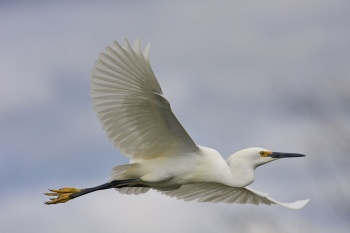- Egretta thula
Identification
(18¾-26¾ in) 47·5–68 cm
- All white plumage
- Nape plume (longer in summer)
- Thin black bill
- Long black legs with yellow feet
- The area between the nostrils and eyes, is yellow but turns red during the breeding season (February-July).
Juvenile: similar to the adult; bill base is paler. The legs have a green or yellow line down the back.
Similar Species
Distribution
Breeds in North America on the east coast from Long Island south to Florida, on the Gulf Coast and inland in the lower Mississippi Valley, on the southern California coast and also in scattered inland areas mainly from the Central Valley of California east to Colorado. To the south breeds on both Mexican coasts and over much of Central America and in South America south to Valdivia in Chile in the west and Buenos Aires, Argentina in the east.
Northernmost and inland populations are migratory and move southwards, coastal birds are more sedentary but post-breeding dispersal takes some birds north to southern Canada.
In the Western Palearctic recorded three times in or near Iceland, and five have been seen in the Azores. The first, and so far only, British record was of an immature on Seil Island in Argyll, Scotland in October 2001 and still present in the general area in June 2002. After a brief disappearance it turned up again on the Solway Firth in September 2002.
Taxonomy
Slightly larger western USA birds are sometimes separated as brewsteri.
Subspecies[1]
- E. t. thula:
- Locally from US to central Argentina and West Indies
- E. t. brewsteri:
- Western US to Baja California and coastal north-western Mexico
Habitat
Lakeshores and riverbanks, mangroves, shallow lagoons and on tidal mudflats and estuaries, sometimes on grasslands.
Behaviour
Breeding
Colonial nesters, forming flat, shallow nests made of sticks and lined with fine twigs and rushes. Three or four greenish-blue, oval eggs are incubated by both adults. The young leave the nest in 20 to 25 days.
Diet
The diet consists of shrimps, small fish, frogs, molluscs, crustaceans, and insects, which are hunted in shallow water.
References
- Clements, J. F., T. S. Schulenberg, M. J. Iliff, S. M. Billerman, T. A. Fredericks, B. L. Sullivan, and C. L. Wood. 2019. The eBird/Clements Checklist of Birds of the World: v2019. Downloaded from http://www.birds.cornell.edu/clementschecklist/download/
- An identification essay comparing Little and Snowy Egrets
- Parsons, K. C. and T. L. Master (2020). Snowy Egret (Egretta thula), version 1.0. In Birds of the World (A. F. Poole and F. B. Gill, Editors). Cornell Lab of Ornithology, Ithaca, NY, USA. https://doi.org/10.2173/bow.snoegr.01
- Wikipedia
- Collins Bird Guide ISBN 0 00 219728 6
Recommended Citation
- BirdForum Opus contributors. (2024) Snowy Egret. In: BirdForum, the forum for wild birds and birding. Retrieved 21 December 2024 from https://www.birdforum.net/opus/Snowy_Egret
External Links
GSearch checked for 2020 platform.1






